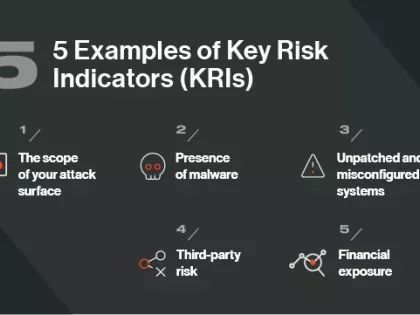How to Identify and Mitigate Digital Transformation Risks


Market pressures and growth opportunities are accelerating digital transformation. According to Gartner, 89 percent of board directors say digital is embedded in all business growth strategies. Meanwhile 99 percent say that digital transformation has had a positive impact on profitability and performance (KPMG).
The cloud, connected IoT devices, and remote work capabilities are the cornerstones of digital transformation. Yet despite the fact that many organizations are turning to emerging technologies, concerns about cyber risks persist. Consider the statistics:
- 81 percent of organizations have experienced a cloud-related security incident in the past 12 months, with 45 percent experiencing at least four incidents (Venafi).
- 42 percent of organizations are behind schedule on cybersecurity implementations for emerging technologies (KPMG).
- 35 percent say the remote/hybrid work environment has posed the greatest cyber challenge (KPMG).
- Enterprise buyers rate cybersecurity as the largest obstacle to IoT adoption (McKinsey).
As digital ecosystems expand and threat actors take advantage of vulnerabilities that are harder to detect, it’s more important than ever that you have broad and continuous visibility into cybersecurity risks inside and outside the network perimeter.
Let’s look at four tips and best practices you can use to identify and mitigate digital transformation risks.
1. Understand your attack surface
To secure your digital transformation efforts, you must get a handle on your organization’s digital assets—on-premises, in the cloud, and across IoT devices and remote networks.
This isn’t always easy, especially since your digital environment is extensive.
To understand what’s going on in your ecosystem and where risk is concentrated you need broad visibility into things most security stacks can’t give you. Tools like Bitsight Attack Surface Analytics can help.
Attack Surface Analytics makes it possible to validate and manage your entire digital footprint—across various geographies, business units, subsidiaries, cloud service providers, and far-flung remote and home offices. With this complete view of your digital assets, you can discover the corresponding cyber risk associated with each and focus resources on assets that are essential to business continuity or would expose sensitive data if breached.
For instance, if a financial services institution has 100,000 digital assets across eight locations, Bitsight will display dashboard views of each and identify, by location, those with security risks or malware infections.
You can also use Attack Surface Analytics to find any materially significant issues within your cloud, such as misconfigured headers, bad SSL certificates, malware, and more. A comparative analysis also allows you to compare the security performance of different cloud providers or geographies.
2. Continuously monitor your extended attack surface
Because risk is constantly emerging, you must monitor for digital transformation risks on an ongoing basis. This is traditionally achieved with occasional cybersecurity audits. But these can be costly, time-consuming, and only capture a record of risks at the time the audit was performed.
But with Bitsight’s continuous monitoring technology, you can keep a constant finger on the pulse of your extended organization’s cyber health (including cloud, IoT, and remote environments). Bitsight automatically scans your attack surface for risk vectors, such as unpatched or misconfigured systems, botnet infections, open ports, SPAM propagation, and other vulnerabilities that are proven to correlate to security incidents.
Security teams are alerted in near real-time the moment risk is detected so they can mobilize quickly to mitigate risk before it’s exploited by a malicious actor.
3. Monitor your digital vendors
Bitsight also extends continuous monitoring to third- and fourth parties, including software and cloud service providers and their subcontractors.
With Bitsight Third-Party Risk Management (TPRM), you can monitor the security posture of vendors and suppliers from due diligence through the life of the relationship—just as NASA and countless others do.
With Bitsight TPRM you can:
- Discover the historical and current security performance of vendors during the onboarding phase, including prior cyber incidents, risky fourth-party connections, and security improvements these companies have made over time (or not).
- Continuously monitor vendor security controls and receive automatic notifications the moment a vulnerability or cyber risk is detected in your vendor portfolio or a vendors’ security performance deviates from thresholds, cybersecurity standards, or contractual agreements.
- Share Bitsight’s findings with vendors for more collaborative risk management.
- Access data about major security events and assess whether your supply chain is impacted, prioritize vendor outreach with built-in questionnaires, and track vendor responses in real time.
4. Measure and report program effectiveness in meaningful ways
Your executive leadership team and board recognize that digital business strategy and traditional business strategy are one and the same—but they also recognize that it comes with risks. In fact, after economic uncertainty, cyber risk—and therefore digital transformation risk—now ranks as the number two concern for boards.
As a security leader, you must think more strategically about measuring and reporting program effectiveness. Stating that the Security Operations Center (SOC) has prevented five network intrusion penetrations in the last 30 days isn’t very helpful to a board member. What does that number mean? Is it good or bad?
Board members want to know what the organization’s cybersecurity performance means in terms of business risks. For example:
- How does the organization’s security performance compare to others in the industry?
- Does it align with cybersecurity frameworks and standards?
- What is the likelihood of a cybersecurity incident as digital transformation efforts continue?
- What is the financial impact of digital transformation risks?
- Is the business demonstrating progress toward better cybersecurity?
Read this article to learn how you can answer those questions and instill confidence in your board.
Want to learn how Bitsight can help your organization thrive through transformation and identify and remediate cybersecurity threats? Contact us for a free demo.


